|

How Does Your Web Site Build Connections?
CLICK is the latest in a series of popular e-newsletters from VisionMonday. Every month, CLICK provides ECPs and optical retailers with
the tools they need to build their presence online and grow connections with patients. It's a monthly briefing designed specifically to provide practical insights and ideas about the latest Web site features, tools and Web-based applications.
CLICK will feature a variety of topics including innovative ideas in Web site development and examples of cutting-edge initiatives. We hope you use it to discover current
Web technologies and learn how online initiatives can help benefit your business. Tried something new on your Web site? Have a comment about CLICK?
Tell us about it and we'll consider it for an upcoming feature in CLICK.
—The Editors

Does Your Web Site Work for People With Vision Disabilities?
NEW YORK—The way consumers interact with brands has completely changed as Internet use, social media engagement and
the use of smart mobile devices have exploded. But how does a blind or low vision user interact with the Internet? Can they shop online? Research companies? Are they able to interact with your
practice’s Web site?
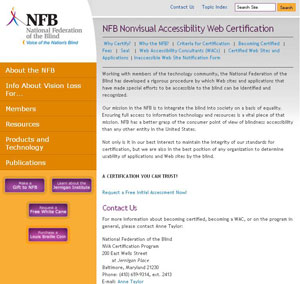 The answer today can be “yes,” and savvy online retailers and health care providers are ensuring, through best practices in Web site accessibility, that blind and low vision consumers are getting the gist of their Web sites’ messages, and complying with the
Americans With Disabilities Act (ADA) in the process. The answer today can be “yes,” and savvy online retailers and health care providers are ensuring, through best practices in Web site accessibility, that blind and low vision consumers are getting the gist of their Web sites’ messages, and complying with the
Americans With Disabilities Act (ADA) in the process.
According to the
National Federation of the Blind (NFB), a “nonvisually accessible” Web site means that screen access software—a screen reader—can obtain sufficient information from the Web application so that it will identify to a blind or low vision user images, charts, tables, links and frame titles.
Accessibility is less about technical savvy and more about diligence. Put simply, in the text version of a Web site (no images, charts, or tables), does the message still make sense? Since JPEG, PDF and other graphic files don’t show up in text version,
the only way for screen readers to identify what those files are there for and what they convey is through spelling out their meaning in their own file names.
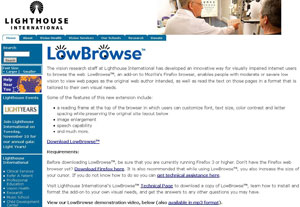 Also available today are such text-to-speech products as
ZoomText to enlarge Web site text a minimum of seven times the normal text size in order to see what’s on a computer screen.
Lighthouse International released a free tool last year called
LowBrowse, which enables low vision Internet users to view original versions of Web pages, as well as read the text versions tailored to their vision needs. Also available today are such text-to-speech products as
ZoomText to enlarge Web site text a minimum of seven times the normal text size in order to see what’s on a computer screen.
Lighthouse International released a free tool last year called
LowBrowse, which enables low vision Internet users to view original versions of Web pages, as well as read the text versions tailored to their vision needs.
It may seem like a lot of work to comply with Web site accessibility. But there are 3.6 million Americans over the age of 40 who are blind or visually impaired, and that number is increasing, according to a
Prevent Blindness America spokesperson. Those include consumers who may have been robust Internet consumers and then lost their vision, and consumers who have always been visually impaired and are comfortable online using their screen
readers or other vision enhancing devices.
Read
VM Special Report: Eye on Web Site Accessibility for a more comprehensive look at what enhancement options are available today and how you can work to make your vision care site more accessible.

Innexus’ Tools Help You Manage Your Practice’s Web Site
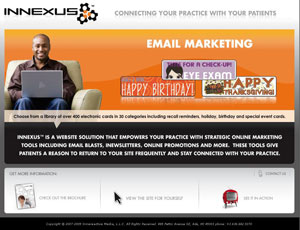 ADA, Mich.—As patients and prospective patients search the Internet for information, having a professional
Web site for your practice has become crucial for your brand and enables your practice to connect with patients throughout the year. ADA, Mich.—As patients and prospective patients search the Internet for information, having a professional
Web site for your practice has become crucial for your brand and enables your practice to connect with patients throughout the year.
Innexus is a new Web
site collection of tools and features that can “empower your practice,” the company notes, with strategic online marketing tools which give patients a reason to return to your site frequently and stay connected with your practice.
Innexus has pioneered what it calls a “Web site attribute” system which enables optical professionals to modify the look and feel of their
Web site with a range of easy-to-use, downloadable tools and solutions. This
offers access to a range of customizable looks, layouts and editorial.
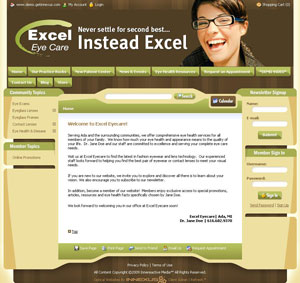 Innexus, a proprietary system
is one of the services developed by Innereactive Media, Inc., a marketing services firm with several years of experience in the eyecare and optical field.
It features the iControl online editing system which lets users
log in from their own Web site to edit text, add pictures, and upload files including PDFs, Word documents, Flash and video clips directly to their
Web site. In addition, iControl provides the ability to create an unlimited number of pages and sub-pages. This gives users complete control over the body content of their
Web site, as well as iNewsletters, iCards, iCalendar, statistics and more. Special iForms enable patients to complete
information prior to their visits. Measurements are managed via Google Analytics. Innexus, a proprietary system
is one of the services developed by Innereactive Media, Inc., a marketing services firm with several years of experience in the eyecare and optical field.
It features the iControl online editing system which lets users
log in from their own Web site to edit text, add pictures, and upload files including PDFs, Word documents, Flash and video clips directly to their
Web site. In addition, iControl provides the ability to create an unlimited number of pages and sub-pages. This gives users complete control over the body content of their
Web site, as well as iNewsletters, iCards, iCalendar, statistics and more. Special iForms enable patients to complete
information prior to their visits. Measurements are managed via Google Analytics.
“Innexus enables ECPs to be much more efficient, effective, and
professional in generating new patients and servicing existing patients 24 hours
a day, 7 days a week,“ said Samantha Toth, the company’s president and founder of Innereactive Media. ”It lets a practice develop a highly visible online presence, and convert
Web site visitors into lifelong patients.”


|

“Social Media: Are You Experienced?”
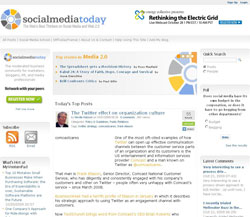
A site loaded with helpful tips for everyone, plus ‘tech’ stuff for your IT staff, SocialMediaToday’s site offers ways of leveraging how you manage your own social network groups, whether it be Facebook, Twitter, Linked In or others.
SocialMedia School offers tutorials, “Social Media in Plain English” is a very quick-study on the topic. Courses and articles help leverage “best practices.”

What Can Harvard Teach You...?
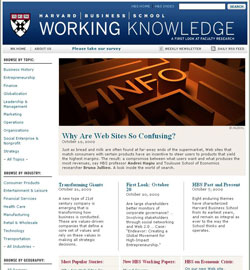
Everyone can attend Harvard Business School at this helpful Web site, a great resource on everything from leadership skills to entrepreneurship and guidance about your Internet presence.
Harvard’s “Working Knowledge” site and related free e-newsletter, brings you both edgy and mainstream ideas as well as useful tips and ‘how-to’ items. One recent article asks, “
Why Are Web Sites So Confusing?”

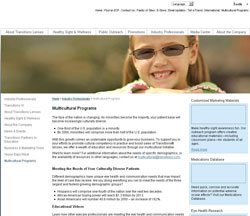
Transitions MultiCultural Programs
Are you doing everything you can to meet the needs of the largest and fastest-growing demographic groups in your practice and on your Web site? Transitions Optical has a resource-rich portion of its site dedicated to
MultiCultural Programs, with resources and tools that can help you enhance your practice’s business with Hispanics, African-Americans,
and Asian Americans. Special reports, educational videos and new tools—including a
new Eye Care Communication Guide for dealing with Spanish-speaking patients.

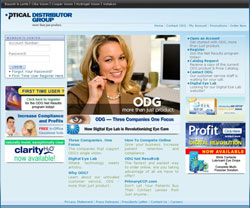
WWW.OPTICALDG.COM
A new program from Optical Distributors Group, called ODG Net Results 2.0 offers ECPs a turnkey solution to keep their contact lens store open 24/7 or 168 hours a week while still maintaining control of their patients.
ECPs enroll their patients in the Net Results program, establish the
prices patients will pay and authorize prescriptions before
shipment. ODG provides customized marketing materials to educate patients about the service and a
comprehensive menu featuring customizable messages, promotional advertisements, and personalized e-mails to send to patients when its time to reorder or set up an appointment.
|